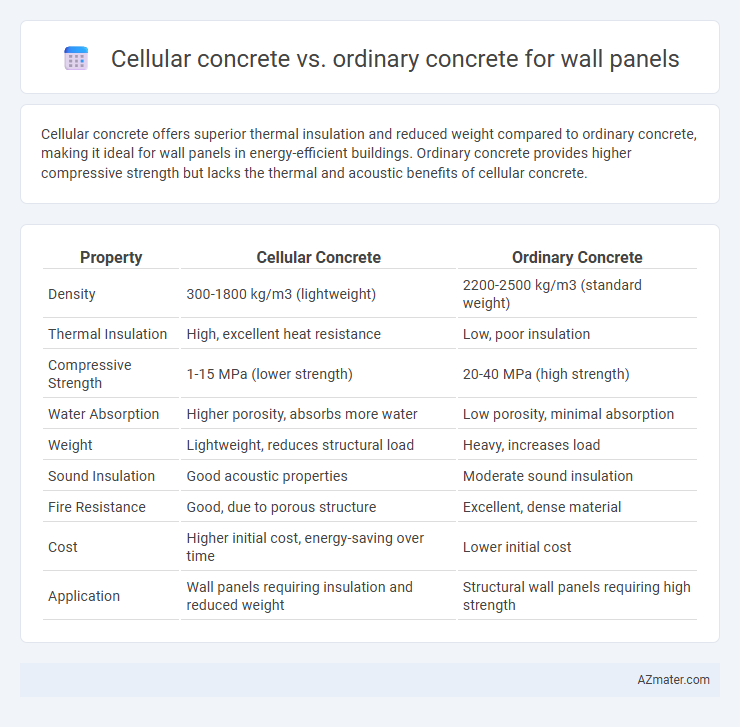Cellular concrete offers superior thermal insulation and reduced weight compared to ordinary concrete, making it ideal for wall panels in energy-efficient buildings. Ordinary concrete provides higher compressive strength but lacks the thermal and acoustic benefits of cellular concrete.
Table of Comparison
| Property | Cellular Concrete | Ordinary Concrete |
|---|---|---|
| Density | 300-1800 kg/m3 (lightweight) | 2200-2500 kg/m3 (standard weight) |
| Thermal Insulation | High, excellent heat resistance | Low, poor insulation |
| Compressive Strength | 1-15 MPa (lower strength) | 20-40 MPa (high strength) |
| Water Absorption | Higher porosity, absorbs more water | Low porosity, minimal absorption |
| Weight | Lightweight, reduces structural load | Heavy, increases load |
| Sound Insulation | Good acoustic properties | Moderate sound insulation |
| Fire Resistance | Good, due to porous structure | Excellent, dense material |
| Cost | Higher initial cost, energy-saving over time | Lower initial cost |
| Application | Wall panels requiring insulation and reduced weight | Structural wall panels requiring high strength |
Introduction to Cellular Concrete and Ordinary Concrete
Cellular concrete, also known as foam concrete, is a lightweight material composed of cement, water, and pre-formed foam, resulting in enhanced thermal insulation and reduced density compared to traditional mixes. Ordinary concrete, made from cement, aggregates, water, and sometimes admixtures, provides high compressive strength but lacks significant insulation properties. Choosing between cellular and ordinary concrete for wall panels depends on factors like load-bearing requirements, thermal efficiency, and overall construction cost.
Composition and Material Differences
Cellular concrete incorporates lightweight aggregates and foam agents, resulting in a porous structure with reduced density compared to ordinary concrete, which uses traditional coarse aggregates like gravel and sand. The presence of air voids in cellular concrete improves thermal insulation and reduces weight, while ordinary concrete offers higher compressive strength due to its denser composition. Cellular concrete's unique formulation combines cement, water, and foam, contrasting with ordinary concrete's mix of cement, water, fine and coarse aggregates designed for structural rigidity.
Weight and Density Comparison
Cellular concrete exhibits a significantly lower density, typically ranging from 400 to 1600 kg/m3, compared to ordinary concrete which has a density around 2400 kg/m3. This reduction in weight enhances ease of handling and reduces structural load for wall panels. Lower density in cellular concrete is achieved through air voids or foam inclusion, making it an ideal choice for lightweight construction applications.
Thermal Insulation Properties
Cellular concrete exhibits superior thermal insulation properties compared to ordinary concrete for wall panels due to its lightweight, porous structure that traps air, significantly reducing heat transfer. This enhanced insulation capability leads to improved energy efficiency in buildings and reduced heating and cooling costs. Ordinary concrete, with its dense composition, offers minimal insulation, making cellular concrete a preferred choice for thermal performance in wall panel applications.
Sound Insulation Capabilities
Cellular concrete offers superior sound insulation capabilities compared to ordinary concrete due to its porous structure, which effectively absorbs and dampens sound waves. The air voids within cellular concrete reduce noise transmission, making it an ideal choice for wall panels in residential and commercial buildings requiring enhanced acoustic performance. In contrast, ordinary concrete's dense composition reflects sound, resulting in higher noise transfer through wall panels.
Structural Strength and Load-Bearing
Cellular concrete exhibits significantly lower structural strength and load-bearing capacity compared to ordinary concrete due to its lightweight and porous composition. Ordinary concrete, with its dense aggregate matrix, provides superior compressive strength essential for wall panels subjected to high loads. Engineers often favor ordinary concrete for load-bearing wall panels where maximum structural integrity and durability are critical.
Installation and Construction Process
Cellular concrete offers a lighter weight and easier handling during installation compared to ordinary concrete, reducing labor time and equipment requirements for wall panel construction. Its flowable consistency enables faster placement and requires less vibration or compaction, streamlining the construction process. Ordinary concrete demands more curing time and intensive reinforcement, increasing the complexity and duration of wall panel installation.
Cost Analysis and Economic Benefits
Cellular concrete offers significant cost savings in wall panel construction due to its lightweight nature, which reduces transportation and labor expenses compared to ordinary concrete. Its enhanced thermal insulation properties decrease energy consumption, leading to long-term economic benefits and reduced building operational costs. Although initial material costs may be slightly higher, the overall life-cycle cost analysis favors cellular concrete for its durability and efficiency in construction projects.
Environmental Impact and Sustainability
Cellular concrete significantly reduces environmental impact compared to ordinary concrete due to its lower density and reduced raw material consumption, leading to decreased carbon emissions during production. Its superior insulation properties contribute to enhanced energy efficiency in buildings, lowering operational carbon footprints over time. The use of recycled materials in cellular concrete formulations further enhances sustainability, making it a preferable choice for eco-friendly wall panels.
Ideal Applications for Wall Panel Projects
Cellular concrete offers superior thermal insulation and lightweight properties ideal for wall panel projects in residential and commercial buildings requiring energy efficiency and ease of installation. Ordinary concrete provides higher structural strength and durability, making it suitable for load-bearing wall panels and heavy-duty applications such as industrial facilities and multi-story constructions. Selecting between cellular and ordinary concrete depends on project priorities like insulation needs, load requirements, and construction speed.

Infographic: Cellular concrete vs Ordinary concrete for Wall panel
 azmater.com
azmater.com